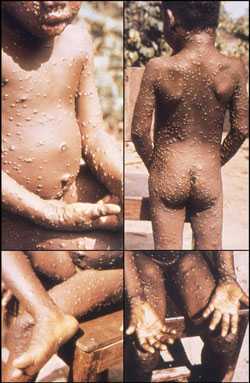About Monkeypox

A child affected with monkeypox.
Monkeypox is a rare disease that is caused by infection with monkeypox virus. Monkeypox virus belongs to the Orthopoxvirus genus in the family Poxviridae. The Orthopoxvirus genus also includes variola virus (the cause of smallpox), vaccinia virus (used in the smallpox vaccine), and cowpox virus.
Monkeypox was first discovered in 1958 when two outbreaks of a pox-like disease occurred in colonies of monkeys kept for research, hence the name ‘monkeypox.’ The first human case of monkeypox was recorded in 1970 in the Democratic Republic of Congo during a period of intensified effort to eliminate smallpox. Since then monkeypox has been reported in humans in other central and western African countries (see table below). The 2003 outbreak in the United States is the only time monkeypox infections in humans were documented outside of Africa.
The natural reservoir of monkeypox remains unknown. However, African rodent species are expected to play a role in transmission.
There are two distinct genetic groups (clades) of monkeypox virus—Central African and West African. West African monkeypox is associated with milder disease, fewer deaths, and limited human-to-human transmission.
| Count | Years | Recorded Human Cases |
|---|---|---|
| Cameroon | 1976 1990 |
2 4 |
| Central African Republic | 1984 | 6 |
| Democratic Republic of Congo | Endemic | |
| Gabon | 1987 1991 |
3 5 |
| Ivory Coast | 1971 1981 |
1 1 |
| Liberia | 1970 | 4 |
| Nigeria | 1971 1978 |
2 1 |
| Republic of Congo | Sporadic | |
| Sierra Leone | 1970 2014 |
1 1 |
| Sudan | 2005 | 19 |
| United States | 2003 | 47 |
Read more detailed information about the U.S. outbreak.
- Page last reviewed: May 11, 2015
- Page last updated: May 11, 2015
- Content Source:


 ShareCompartir
ShareCompartir